Winter Feeding Cost Comparison – Hay vs. Alternative Feeds
Remarque : cette page web n’est actuellement disponible qu’en anglais.
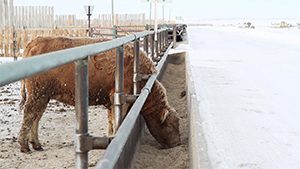
Fall has arrived and focus has shifted to winter feed supplies. Feed prices have dropped significantly from their June highs, but unfavorable weather conditions have left the question of available supplies. Hay prices vary significantly with prices in some areas with short supplies nearly double those in areas with adequate supplies. On the other hand, there could be numerous options for alternate winter feeds this year as some crops originally intended for grain are being harvested as livestock feed. Harvest delays and the likelihood of frost damage has led to quality downgrades. Alberta feed barley prices have dropped 13% from the June peak at $205/ton to $179/ton in September, and market analysts project that the feed grain markets have not hit bottom yet.
In eastern Canada, last year’s fall and winter conditions caused significant winter kill on the winter wheat and hay crops, while spring planting was delayed due to excessive moisture. According to local market reports, the fears of supply shortage have sent Ontario wheat straw prices to $0.06-0.10/lb in some areas compared to the historical range of $0.03-0.04/lb. Cool, wet weather in August and September are also causing harvest delays in the east, with the possibility of more cereal crops going to the feed market.
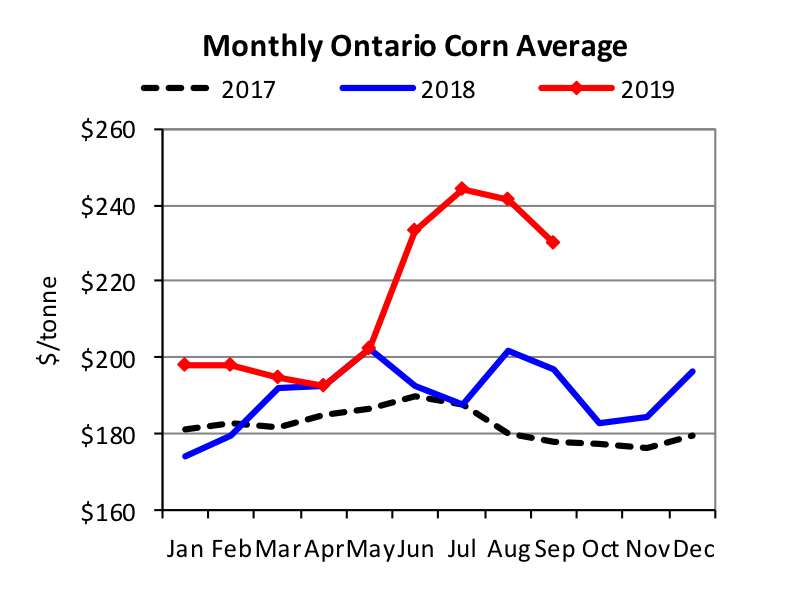

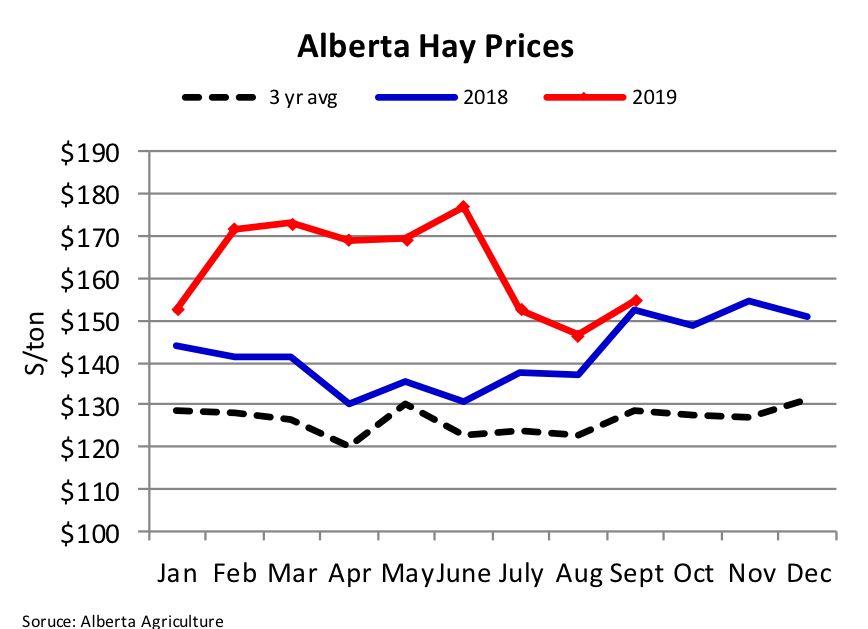
(Click on charts to enlarge)
Opportunities to Reduce Feed Costs
Winter feed costs are the largest variable cost for cow-calf production. With the increased availability and falling prices of alternative winter feeds in some areas, there could be a good opportunity to reduce wintering costs by using alternative feed sources this year.
How will the use of alternative feeds affect winter feeding costs this year?
Producers can use BCRC’s decision making tool Winter Feed Cost Comparison Calculator to calculate and compare the costs of main feed ingredients in different rations.
Based on feed ration examples available on provincial government websites, the cost of main feed ingredients in different rations are estimated for beef cows at 1,400 lbs in mid-pregnancy with a body condition score of three.
Two price scenarios are considered: scenario one assumes that hay and alternative feed prices are steady with the most current published prices; scenario two assumes steady hay prices and declines in alternative feed prices based on Agriculture and Agri-Food Canada’s grain price projections for the 2019/20 crop year.
It should be noted that this analysis only includes the main feed ingredients, while other costs such as vitamins, minerals, yardage, and labour are excluded.
Table 1. Rations and Estimated Costs for Main Feed Ingredients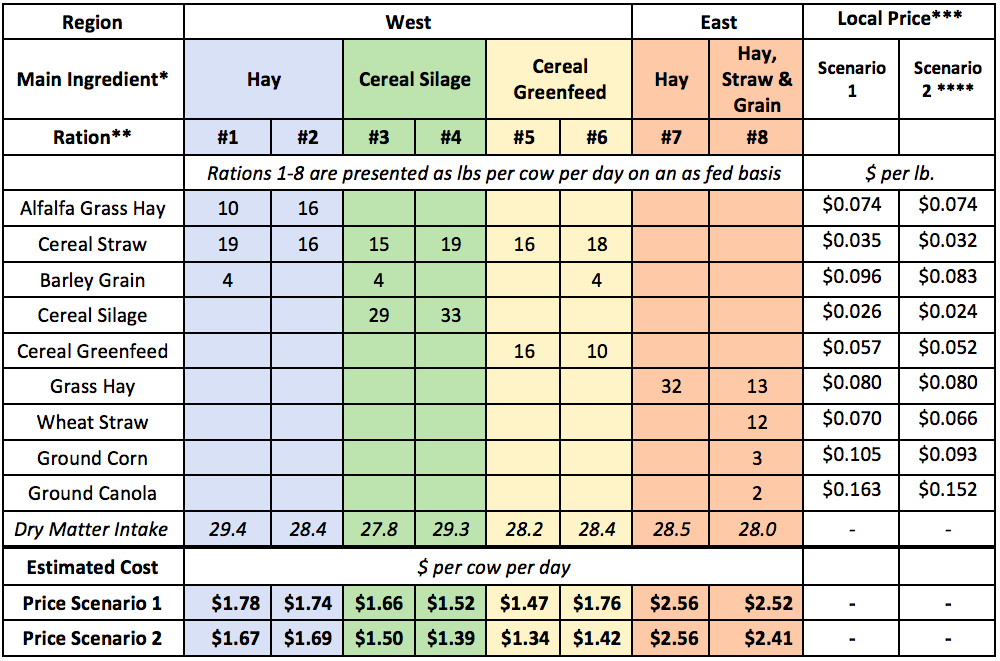 * Ration examples and nutrient values of feed sourced from Saskatchewan Agriculture winter feeding guidelines and Ontario Agriculture Coping with Hay Shortage in Beef Cow Wintering Ration
* Ration examples and nutrient values of feed sourced from Saskatchewan Agriculture winter feeding guidelines and Ontario Agriculture Coping with Hay Shortage in Beef Cow Wintering Ration
**These rations require supplemental minerals, vitamins and salt
*** Prices sourced from Alberta Agriculture Farm Input Prices report (Aug, 2019), Saskatchewan Forage Market Price Discovery Report (Aug-Dec 2018), Manitoba Forage and Grassland Association Hay Relief Reports (Sept, 2019), Ontario Hay Listing (Sept, 2019), Beef Farmers of Ontario, Canola Council of Canada
**** Projections based on Agriculture and Agri-Food Canada Outlook for Principle Field Crops (Sept 2019) projected prices
The cost comparisons in Table 1 shows that rations based on silage and greenfeed generally cost less than the hay-based rations in both western and eastern Canada, based on these price assumptions. For example, at current price levels, the main ingredients (alfalfa hay and cereal straw) in ration #2 are estimated to cost $1.74 per cow per day compared to ration #5 (Cereal Straw and Greenfeed) at $1.47 per cow per day, which is a 16% difference. For a 150-day winter feeding period for 100 cows, this represents a $4,000 difference in total feeding costs. If hay prices stay steady and alternative feeds prices go lower, the cost difference between the two rations would expand to about 20% or $5,250 for 100 cows with a 150-day feeding period.
Precautions
While the above analysis shows the potential cost savings by using alternative winter feeds, producers should consider what their individual feed costs are, along with local feed availability. There are still a lot of uncertainties in terms of regional supplies and prices of forage and feed grains at this point, depending on where you are and how harvest turns out this year.
When considering alternative feed sources, feed testing is important to test for nutritive value to ensure a balanced ration that meets the nutritional needs of the herd. Testing can also identify quality or toxin issues such as nitrates, sulphur, or mycotoxins. Any new feed should be introduced gradually to allow cattle to adjust to the different texture and taste. Feed rations should be adjusted according to the cows’ body condition and weather conditions (see Table 2).
Table 2. Nutrient Requirements for Pregnant Cows and Bred Heifers*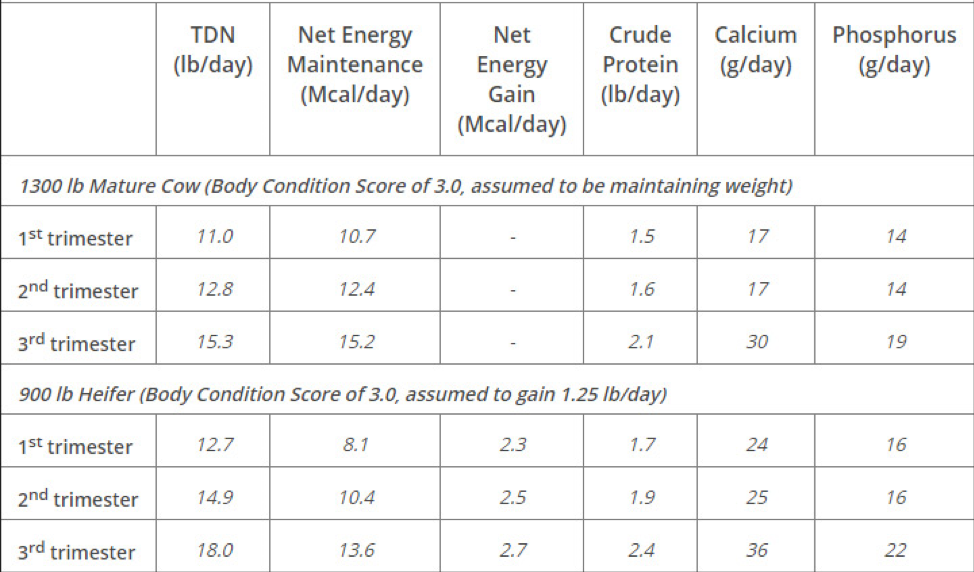 *Values are from www.BeefResearch.ca and were generated using Alberta Agriculture’s CowBytes Program, with assumptions including breeding for June 1 calving, typical Canadian winters, access to shelter from wind and a daily gain of 1.25 pounds for bred heifers in addition to weight gain from pregnancy.
*Values are from www.BeefResearch.ca and were generated using Alberta Agriculture’s CowBytes Program, with assumptions including breeding for June 1 calving, typical Canadian winters, access to shelter from wind and a daily gain of 1.25 pounds for bred heifers in addition to weight gain from pregnancy.
Source: BCRC, Feed Testing & Analysis for Beef Cattle
| Extended Winter Grazing |
|---|
| While the above analysis focuses on alternative winter feeds, extended grazing, such as stockpiled perennial forages, use of annual forages, crop residues, and bales left in the field, have considerable economic and environmental benefits over traditional winter-feeding systems. For example, research indicates that swath grazing can reduce total daily feeding cost per cow by 41 to 48% compared to drylot feeding. For more information about extended winter grazing, visit Extended Grazing |
Learn More:
- Drought Management Strategies (BCRC post)
- Feed Testing & Analysis for Beef Cattle (BCRC webpage)
- Mycotoxins (BCRC webpage)
- Stored Forages (BCRC webpage)
- Stretching Feed Supplies (BCRC post)
Click here to subscribe to the BCRC Blog and receive email notifications when new content is posted.
The sharing or reprinting of BCRC Blog articles is welcome and encouraged. Please provide acknowledgement to the Beef Cattle Research Council, list the website address, www.BeefResearch.ca, and let us know you chose to share the article by emailing us at info@beefresearch.ca.
We welcome your questions, comments and suggestions. Contact us directly or generate public discussion by posting your thoughts below.